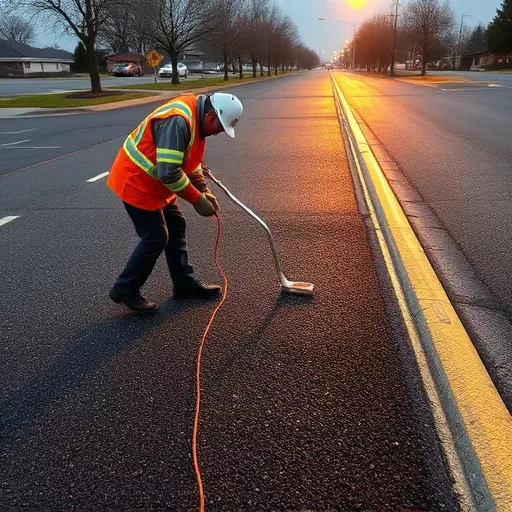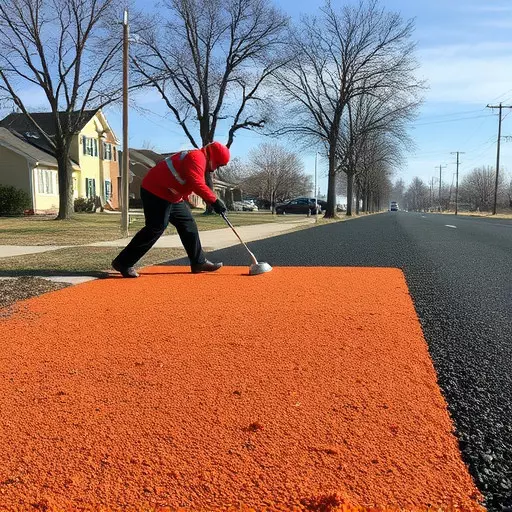Toledo faces unique challenges with harsh weather, requiring efficient asphalt patching solutions. Infrared asphalt patching and cold patch asphalt services offer modern alternatives. Infrared technology softens existing asphalt for stronger bonding, while cold patch provides quick, cost-effective repairs. These methods extend road lifespans, enhance aesthetics, and cater to diverse damage scenarios, ensuring residents in Toledo have durable, long-lasting pavement maintenance options.
In the realm of asphalt maintenance, effective crack management is key. This article explores two prominent methods: crack filling and asphalt patching, focusing on their distinct roles in preserving road surfaces. We delve into the benefits of crack filling, where specialized materials seal cracks to prevent water intrusion and delay further damage. Additionally, we highlight the emerging role of Infrared Technology in efficient asphalt patching processes. Further, discover how Cold Patch Asphalt Services offer a cost-effective, quick-drying solution for temporary repairs, catering to Toledo’s diverse weather conditions.
- Understanding Crack Filling and Its Benefits
- The Role of Infrared Technology in Asphalt Patching
- Advantages and Considerations of Cold Patch Asphalt Services
Understanding Crack Filling and Its Benefits

Crack filling is a process that involves injecting a special polymer-based material into existing cracks in asphalt surfaces. Unlike traditional patching methods, which merely cover up cracks, crack filling actually penetrates and fills them from within, creating a stronger, more durable repair. This method is particularly effective for preventing further damage caused by water seepage and freeze-thaw cycles, common issues in harsh climates like Toledo’s.
One innovative approach to crack filling is the use of infrared asphalt patching. This technology utilizes heated equipment to soften the existing asphalt, allowing the crack filler to bond more effectively with the surrounding surface. Additionally, cold patch asphalt services offer a quick and efficient solution for smaller cracks, providing temporary relief until a more permanent fix can be scheduled. These modern asphalt patching methods not only enhance the lifespan of roads and parking lots but also contribute to the overall aesthetic appeal of the Toledo landscape.
The Role of Infrared Technology in Asphalt Patching

In recent years, Infrared Technology has emerged as a game-changer in the field of asphalt patching, particularly in regions like Toledo where weather conditions can pose challenges for traditional methods. This innovative approach offers a more efficient and effective solution for repairing damaged roads and parking lots. With Infrared Asphalt Patching, heated air is used to soften the existing asphalt, allowing for better adhesion when applying new material. This advanced technique sets it apart from conventional cold patch asphalt services, ensuring longer-lasting repairs that can withstand heavy traffic and extreme temperatures.
By utilizing infrared energy, technicians can precisely heat the affected area, creating a fusion layer that bonds new patch material securely to the existing surface. This method minimizes the need for extensive preparation, saving time and resources. Moreover, Infrared Technology is particularly beneficial for quick response to road damage during the winter months, when cold temperatures often hinder traditional patching processes.
Advantages and Considerations of Cold Patch Asphalt Services

Cold patch asphalt services offer several advantages for quick and effective repairs, especially in areas like Toledo where weather conditions can be harsh. This innovative method involves using a cold-applied material that is easily installed and can withstand lower temperatures, making it ideal for immediate fixes during any season. The process is swift; the cold patch is simply poured into the cracks and compacted, providing an instant solution to prevent further damage.
When considering asphalt patching methods, infrared asphalt patching stands out as a modern approach. This technology utilizes heat to activate the asphalt, ensuring a strong bond between the repair material and the existing surface. While it may be more costly than traditional cold patch services, its benefits include longer-lasting repairs and reduced risk of future damage. This method is particularly useful for larger cracks or areas requiring significant reinforcement.


